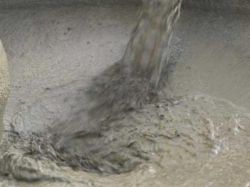Revival of concrete, or rather, its secondary discovery, refers to the end of the XVIII century. For a period, Britain was the leader, having risen earlier than other countries to the path of industrial development. John Smith used concrete to build a dam on the river. Calder (1760) and in the foundations of some buildings in Westminster.
At the moment, there are some disputes about the beginning of use and production of concrete in Russia. So already in 1825, E. G. Cheliev, the leading architect of Russia publishes a book on the production of cement and concrete. That is, only a year after the patent of J. Aspdin. However, there is evidence that even when Moscow was rebuilt after the fire of 1812, Ye. G. Cheliev used concrete for the construction of foundations of buildings and as a connecting element of the brickwork. There is also evidence that in Russia cement and concrete on its basis appeared already at the beginning of the XVIII century. In 1728 - 1729 years. On the construction of the Ladoga Canal, cement was used at the Konorsky cement plant (St. Petersburg province). Just hydraulic binders based on lime and chopped weakly burned bricks were used even in the times of Kievan Rus.
However, it is worth noting that Chelishchev strictly used and created a silicate concrete. And when constructing the Ladoga Canal, slightly burnt material (up to 900 degrees) was used, comparable in properties with concrete on the basis of J. Parker's cement (1796). That is, this mixture is not a full-fledged concrete, which acquires its full properties only after 1400 degrees of roasting. And the patent for the modern standard of concrete (portland cement) without conditional belongs to J. Aspdin and was received in 1824.
The creation of the domestic cement industry made it possible, in 1900, to produce 577,000 tons of concrete per year, and in 1913 to 1.8 million tons of concrete, which was one of the main material conditions for the development of concrete and reinforced concrete and their introduction into Practice. We can say that in the history of domestic concrete a new stage has begun, which can be called a "stage of scientific and industrial development."
In 1856, the first Russian plant producing portland cement was launched in Grozdec, then in 1866 a cement plant was established in Riga, in 1870 - in Shchurov, in 1871 - in Punan-Kunda, in 1874 - in Podolsk, in 1882 - in Novorossiysk.
A great contribution to the science of cement and concrete, and the mastery of its production, was made by Russian scientists NA Belelyubsky, NN Lyamin, IG Malyuga, VI Charnomsky, A R. Shulyachenko, AA Baikov, PP Budnikov, Yu. M. Butt, and AV Volzhensky. As soon as scientists began to study cement concrete, they were faced with a lot of problems that required them to penetrate into the mysteries of chemical processes and the physical structure of the material
In the development and scientific knowledge of concrete in the late XIX - early XX century. We can confidently say that the USSR and Russia occupied one of the leading places in the 20th century. Bethon is widely used in the construction of ports (Odessa, 1870s), sewer collectors (Petersburg), fortifications (Sevastopol, 1885, Kronshtadt, 1900). The large scale of concrete application in Russia is evidenced by the fact that by 1900 there were already more than 66 concrete plants and polygons, in 1913 about 3.5 million m3 of concrete were used in the construction.
According to data for 1914 in our country there were about 60 factories for the production of cement, which produced approximately 1.6 million tons of products. In 1962, the USSR was the leader in the production of cement throughout the world.
Каталог
Russian history of cement and concrete
Технические характеристики





